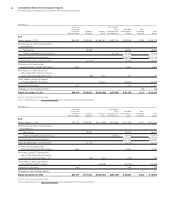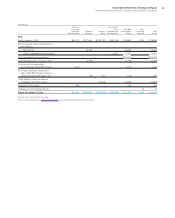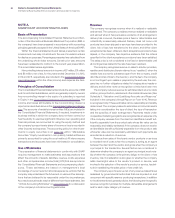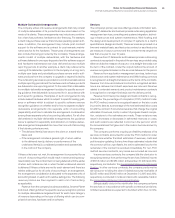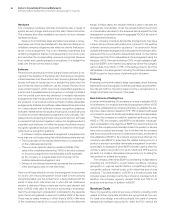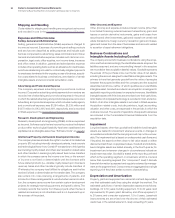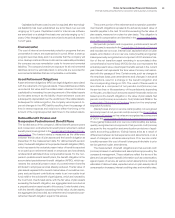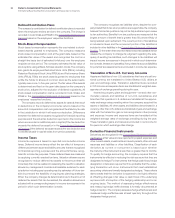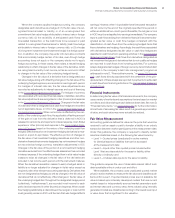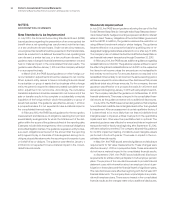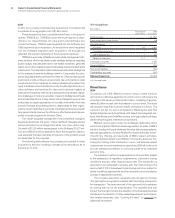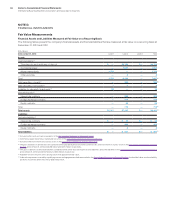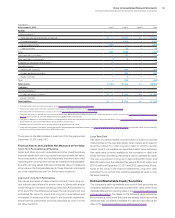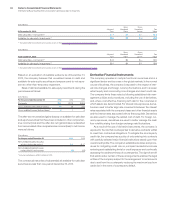IBM 2013 Annual Report Download - page 93
Download and view the complete annual report
Please find page 93 of the 2013 IBM annual report below. You can navigate through the pages in the report by either clicking on the pages listed below, or by using the keyword search tool below to find specific information within the annual report.
Notes to Consolidated Financial Statements
International Business Machines Corporation and Subsidiary Companies
92
The determination of fair value considers various factors includ
-
ing interest rate yield curves and time value underlying the financial
instruments. For derivatives and debt securities, the company uses
a discounted cash flow analysis using discount rates commensurate
with the duration of the instrument.
In determining the fair value of financial instruments, the com-
pany considers certain market valuation adjustments to the “base
valuations” calculated using the methodologies described below
for several parameters that market participants would consider in
determining fair value:
• Counterparty credit risk adjustments are applied to financial
instruments, taking into account the actual credit risk of a
counterparty as observed in the credit default swap market
to determine the true fair value of such an instrument.
• Credit risk adjustments are applied to reflect the company’s
own credit risk when valuing all liabilities measured at
fair value. The methodology is consistent with that applied
in developing counterparty credit risk adjustments, but
incorporates the company’s own credit risk as observed
in the credit default swap market.
As an example, the fair value of derivatives is derived utilizing a dis-
counted cash flow model that uses observable market inputs such
as known notional value amounts, yield curves, spot and forward
exchange rates as well as discount rates. These inputs relate to
liquid, heavily traded currencies with active markets which are avail-
able for the full term of the derivative.
Certain financial assets are measured at fair value on a nonrecur-
ring basis. These assets include equity method investments that are
recognized at fair value at the measurement date to the extent that
they are deemed to be other-than-temporarily impaired. Certain
assets that are measured at fair value on a recurring basis can be
subject to nonrecurring fair value measurements. These assets
include available-for-sale equity investments that are deemed to
be other-than-temporarily impaired. In the event of an other-than-
temporary impairment of a financial instrument, fair value is measured
using a model described above.
Accounting guidance permits the measurement of eligible finan-
cial assets, financial liabilities and firm commitments at fair value, on
an instrument-by-instrument basis, that are otherwise not permitted
to be accounted for at fair value under other accounting standards.
This election is irrevocable. The company does not apply the fair
value option to any eligible assets or liabilities.
Cash Equivalents
All highly liquid investments with maturities of three months or less at
the date of purchase are considered to be cash equivalents.
Marketable Securities
Debt securities included in current assets represent securities that
are expected to be realized in cash within one year of the balance
sheet date. Long-term debt securities that are not expected to be
realized in cash within one year and alliance equity securities are
included in investments and sundry assets. Debt and marketable
equity securities are considered available for sale and are reported
at fair value with unrealized gains and losses, net of applicable taxes,
in OCI. The realized gains and losses for available-for-sale securities
are included in other (income) and expense in the Consolidated
Statement of Earnings. Realized gains and losses are calculated
based on the specific identification method.
In determining whether an other-than-temporary decline in market
value has occurred, the company considers the duration that, and
extent to which, the fair value of the investment is below its cost; the
financial condition and near-term prospects of the issuer or underly-
ing collateral of a security; and the company’s intent and ability to
retain the security in order to allow for an anticipated recovery in fair
value. Other-than-temporary declines in fair value from amortized
cost for available-for-sale equity and debt securities that the company
intends to sell or would more likely than not be required to sell before
the expected recovery of the amortized cost basis are charged to
other (income) and expense in the period in which the loss occurs.
For debt securities that the company has no intent to sell and believes
that it more likely than not will not be required to sell prior to recovery,
only the credit loss component of the impairment is recognized in
other (income) and expense, while the remaining loss is recognized
in OCI. The credit loss component recognized in other (income) and
expense is identified as the amount of the principal cash flows not
expected to be received over the remaining term of the debt security
as projected using the company’s cash flow projections.
Inventories
Raw materials, work in process and finished goods are stated at the
lower of average cost or market. Cash flows related to the sale of
inventories are reflected in net cash provided by operating activities
in the Consolidated Statement of Cash Flows.
Allowance for Credit Losses
Receivables are recorded concurrent with billing and shipment of a
product and/or delivery of a service to customers. A reasonable
estimate of probable net losses on the value of customer receivables
is recognized by establishing an allowance for credit losses.
Notes and Accounts Receivable—Trade
An allowance for uncollectible trade receivables is estimated based
on a combination of write-off history, aging analysis and any specific,
known troubled accounts.


